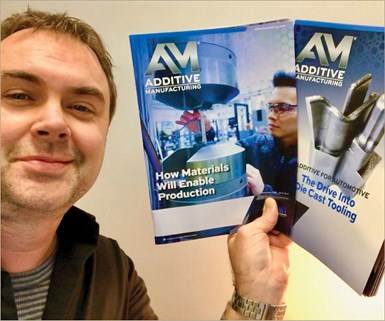Shifting Landscape of Technology Is a Never-Ending Education
Brent Donaldson, Senior Editor, Modern Machine Shop and Additive Manufacturing Magazine discusses how the shifting landscape of technology that all of Gardner’s writers and editors cover is a never-ending education. If we are truly doing our jobs, we will never feel like we’ve mastered them. As I continue writing and reporting for AM and MMS, it’s easy to imagine how these technologies’ interdependency will continue to grow. It also seems clear that this kind of reporting — the kind that requires editors to experience and share new manufacturing technologies and strategies — is the kind of reporting that only Gardner can produce with any depth. I’m grateful to be part of it.
#brandbuilding #workforcedevelopment
Employee Spotlight Profile
Brent Donaldson, Senior Editor
Modern Machine Shop and Additive Manufacturing Magazine
 Brent Donaldson proudly displays two of his recent cover features for Additive Manufacturing Magazine.
Brent Donaldson proudly displays two of his recent cover features for Additive Manufacturing Magazine.A former boss once made a prediction that put me at ease during my first week on the job. I was editor-in-chief of a university magazine, but also had responsibilities related to event planning, script writing, video and digital media production. “It’s going to take time to learn this role, and that’s OK,” she said, taking mercy on me. In fact, she added, it would likely take a full three years before I truly understood all of the ins and outs of the position.
Clearly this was an overestimate to make me feel better, I thought. I’ll have things locked down within a year!
I didn’t. It took me three years to not only learn the job, but also to learn that her advice was exactly right.
By the beginning of my fourth year I was able to comfortably navigate every aspect of my role there. I had established a deep list of contacts. I knew exactly where to go and who to call when I needed information. Most importantly, I had gained the confidence to propose new ideas and execute the good ones.
This coming May 31 will mark my three-year anniversary as a senior editor writing for Modern Machine Shop (MMS) and Additive Manufacturing Magazine (AM). While there are similarities between how I felt at this point during my last job and how I feel today, it’s not really a fair comparison. The shifting landscape of technology that all of Gardner’s writers and editors cover necessitates a never-ending education on our part. If we are truly doing our jobs, we will never feel like we’ve mastered them.
I started my role with Gardner as fulltime editor for AM, with the stipulation that I might later transition to splitting my time between AM and Modern. That transition happened roughly a year ago, and it didn’t take long to realize what a smart strategy it was.
Additive manufacturing (the technology) is in many ways more complex than what we think of as traditional machining. The number of variables involved with a single build can be overwhelming, especially when creating complex metal parts for serial production. Replicating an exact build geometry hundreds of times across several machines while maintaining nearly identical material properties is both machine- and process-dependent. Again and again, processes must be strictly followed on machines that are precisely calibrated. This challenge is acute in heavily regulated industries such as commercial aviation, where suppliers are required to follow qualification and equivalency standards issued by the FAA. As I wrote about last year, we are only now starting to see industrialized metal additive production in the aerospace sector.
But — and it’s a big but — something about additive manufacturing makes it more intuitive to those (like me, 2.5 years ago) who have limited experience with 3D printing technologies. The core idea behind 3D printing is broadly accessible: a printer builds shapes, layer by layer in three dimensions based on a CAD model.
Contrast that with CNC machining and other metalworking technologies that Modern Machine Shop has covered for nearly a century. It may not take a lifelong machinist to understand the core functionality of a lathe, but the universe of CNC machining is just insanely vast. It is a universe complete with its own language, and it is filled with concepts and a machining vernacular understood only by those who live it. The result, for me, was a steeper learning curve than when I began covering AM.
But an emerging trend is smoothing out that curve: interlocking, multi-brand stories.
Additive manufacturing is rarely a self-contained process. Nearly all metal additive builds require heat treatment or machining to achieve a desired microstructure, finished shape and meet required tolerances. This is likely to remain true for the foreseeable future.
A recent example emerged after I wrapped up an article for Modern about one of the largest five-axis machining centers in the United States: the Emco Mecof PowerMill located at Baker Industries near Detroit. Baker is a subcontract manufacturer that primarily serves the OEM and Tier-One aerospace and automotive sectors, and the company has long specialized in work that necessitates the operation of large machining centers.
When I wrote about Baker last summer, I mentioned that the company had recently been purchased by Lincoln Electric, the 125-year-old global manufacturer of welding equipment. I casually referenced the acquisition out of due diligence; it had nothing to do with my story, I thought.
Wrong!
A few months later I was near Cleveland visiting Lincoln Electric Additive Solutions, a new additive manufacturing division of Lincoln Electric that produces massive 3D-printed parts via a wire arc additive manufacturing process akin to welding. Toward the end of my interviews I learned that Lincoln’s purchase of Baker was explicitly because of Baker Industries’ ability to machine large parts. Examples of these parts include aerospace tooling for composites, including large, asymmetrical facesheet tools that often take months to manufacture. The process can take months, not only because of the scarce availability of raw materials such as Invar, but also because facesheet tools require significant amounts of time to fabricate and machine on CNC machines large enough to handle them.
Enter the PowerMill — a vertical machining center with a worktable large enough to park a semi-truck.
After writing about Lincoln Electric, I circled back to my sources at Baker and am putting together a followup story that tackles machining large 3D-printed parts.
As I continue writing and reporting for AM and MMS, it’s easy to imagine how these technologies’ interdependency will continue to grow. It also seems clear that this kind of reporting — the kind that requires editors to experience and share new manufacturing technologies and strategies — is the kind of reporting that only Gardner can produce with any depth. I’m grateful to be part of it.
Need more information?
Brent Donaldson, Senior Editor
Modern Machine Shop and Additive Manufacturing Magazine
513-338-2263
About the Author
Brent Donaldson
Brent is Senior Editor for Additive Manufacturing Magazine and Modern Machine Shop, specializing in long-form feature articles related to machining and all-things-AM and industrial 3D printing. Before joining Gardner, Brent was editor-in-chief of Northern Kentucky University Magazine — the same university from which he received his journalism degree in 2005. Brent previously served as associate editor for Cincinnati Magazine, and is the recipient of two Ohio Excellence in Journalism awards for feature news writing, Cincinnati Society of Professional Journalists awards, and more than 40 individual awards from the Council for Advancement and Support of Education for writing and editorial. Outside of Gardner Business Media, Brent moonlights as co-host and producer of the “Ripley’s Believe It or Notcast,” the official podcast of Ripley’s Believe It Or Not!
Fun fact: Brent was the last journalist ever to interview Evel Knievel.
RELATED CONTENT
-
Best Practices in Plants with In-Plant Stories
From the very beginning Gardner has served manufacturing by writing about best practices with most feature articles written by Gardner editors. They write about success stories where companies are using technology to produce better quality parts at lower costs.
-
Post-COVID Considerations for B2B Marketers
While we begin to return to “normal” from COVID-19, there are lessons for B2B marketers to learn and actions to take to recover and grow business as a result of this experience. Change is in order in how we look at B2B marketing, and our customers, in the near term “post-COVIDian” future. Call it a commonsense approach, rooted in proven best practices, our new-found “pull together” mentality and need to adapt to change. Not a blueprint, just parts and pieces to frame thinking. Sum it up in 5 words: Consistency; Community; Integrity; Agility; Contingency.
-
Guide to Generate Leads with Your Content Marketing
With a solid content marketing strategy and these steps in place, your content marketing campaigns will generate leads online like a well-oiled machine.


